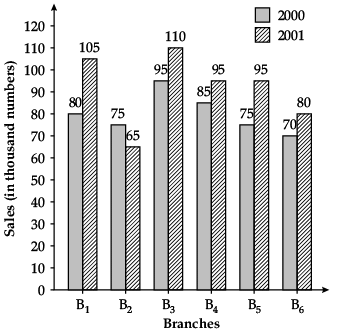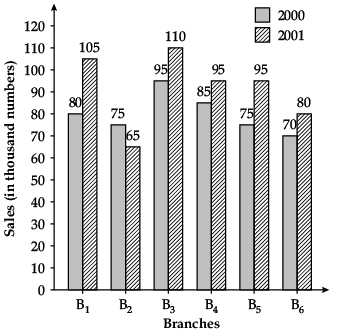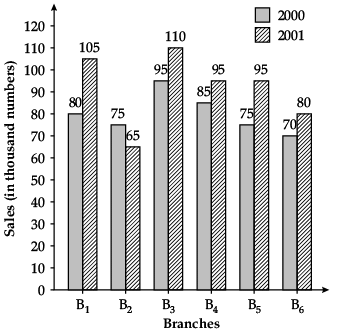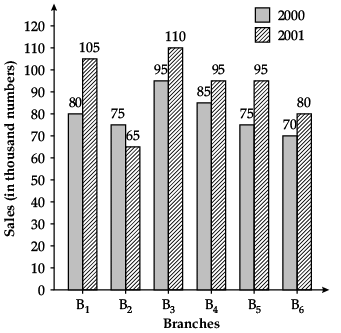Test: Collection, Organisation and Presentation of Data- Case Based Type Questions - Commerce MCQ
8 Questions MCQ Test - Test: Collection, Organisation and Presentation of Data- Case Based Type Questions
Read the following passage and answer the question that follows:
Census is not only the oldest research, best-known, well-formed in terms of methodology, but also a research, which is widely regarded as the most reliable data source. As the methods of conducting the census and especially of data collecting have changed incredibly over the last decades, it seems appropriately important to address the issue of quality assessment of census.
Modern technologies, its development and application in all spheres of social and economic life has also influenced population census methodology. Huge changes and modifications can be seen at every stage of the census procedure, and in principle were observed in all countries around the world.
Some countries have opted for fundamental change in methodology that is the source of data, while the other only introduced some innovations in the technology of its collecting and processing. The main idea of these changes is savings, but also improvement of census data quality.
To assess the quality of the census different methods may be used. The classification of sources of errors indicates coverage and content errors. In estimation of population size one of key factors in determining the census is coverage. But
Considering the change in census methodology, besides non-random, also random errors should be discussed. As the census used data from different sources, including, registers, self-enumeration, but also sample surveys, which were integrated in one database, evaluation should be comprehensive and a clear description of estimation technique needs to be provided.
Q. With the change in technologies, which of the following is not true regarding the collection of censuses?
Read the following passage and answer the question that follows:
Census is not only the oldest research, best-known, well-formed in terms of methodology, but also a research, which is widely regarded as the most reliable data source. As the methods of conducting the census and especially of data collecting have changed incredibly over the last decades, it seems appropriately important to address the issue of quality assessment of census.
Modern technologies, its development and application in all spheres of social and economic life has also influenced population census methodology. Huge changes and modifications can be seen at every stage of the census procedure, and in principle were observed in all countries around the world.
Some countries have opted for fundamental change in methodology that is the source of data, while the other only introduced some innovations in the technology of its collecting and processing. The main idea of these changes is savings, but also improvement of census data quality.
To assess the quality of the census different methods may be used. The classification of sources of errors indicates coverage and content errors. In estimation of population size one of key factors in determining the census is coverage. But
Considering the change in census methodology, besides non-random, also random errors should be discussed. As the census used data from different sources, including, registers, self-enumeration, but also sample surveys, which were integrated in one database, evaluation should be comprehensive and a clear description of estimation technique needs to be provided.
Assertion (A): Census is widely regarded as the most reliable data source.
Reason (R): The statistician observes every item personally.
Select the correct alternative from the following:
Read the following passage and answer the question that follows:
Census is not only the oldest research, best-known, well-formed in terms of methodology, but also a research, which is widely regarded as the most reliable data source. As the methods of conducting the census and especially of data collecting have changed incredibly over the last decades, it seems appropriately important to address the issue of quality assessment of census.
Modern technologies, its development and application in all spheres of social and economic life has also influenced population census methodology. Huge changes and modifications can be seen at every stage of the census procedure, and in principle were observed in all countries around the world.
Some countries have opted for fundamental change in methodology that is the source of data, while the other only introduced some innovations in the technology of its collecting and processing. The main idea of these changes is savings, but also improvement of census data quality.
To assess the quality of the census different methods may be used. The classification of sources of errors indicates coverage and content errors. In estimation of population size one of key factors in determining the census is coverage. But
Considering the change in census methodology, besides non-random, also random errors should be discussed. As the census used data from different sources, including, registers, self-enumeration, but also sample surveys, which were integrated in one database, evaluation should be comprehensive and a clear description of estimation technique needs to be provided.
Q. In a sample survey, the database integration and evaluation should be ..................... and clear.
Read the following passage and answer the question that follows:
Census is not only the oldest research, best-known, well-formed in terms of methodology, but also a research, which is widely regarded as the most reliable data source. As the methods of conducting the census and especially of data collecting have changed incredibly over the last decades, it seems appropriately important to address the issue of quality assessment of census.
Modern technologies, its development and application in all spheres of social and economic life has also influenced population census methodology. Huge changes and modifications can be seen at every stage of the census procedure, and in principle were observed in all countries around the world.
Some countries have opted for fundamental change in methodology that is the source of data, while the other only introduced some innovations in the technology of its collecting and processing. The main idea of these changes is savings, but also improvement of census data quality.
To assess the quality of the census different methods may be used. The classification of sources of errors indicates coverage and content errors. In estimation of population size one of key factors in determining the census is coverage. But
Considering the change in census methodology, besides non-random, also random errors should be discussed. As the census used data from different sources, including, registers, self-enumeration, but also sample surveys, which were integrated in one database, evaluation should be comprehensive and a clear description of estimation technique needs to be provided.
Q. With the incredible change in the conducting of census and data collection, which of the following issues needs to be addressed?
Read the following passage and answer the questions that follows:
India’s book market, currently worth ₹261 billion making it the sixth largest in the world and the second largest of the English language ones, is expected to touch ₹739 billion by 2020, says a survey. A growing literacy rate, estimated to reach 90% in 2020, government spending on education, digital initiatives, and outsourcing of publishing services to India, are all identified as the strengths of the Indian publishing industry. While the market is highly fragmented, it is also experiencing consolidation, in part as a result of the involvement of foreign multinationals.
The study calculates that 55% of trade sales are books in English. Books in Hindi account for 35% of the balance, i.e., the Indian language sales. Books in English account for a majority of professional book sales (90%) and two-thirds of educational sales; but more than half of the fiction sold in India is in other languages.
The educational book market in India is growing at a tremendous rate. According to the report, the K–12 market (school books) has grown from 63 billion rupees ($ 956 million) in 2007-08 to 186 billion ($D2.8 billion) in 2013-14. Higher education book sales have grown in this period from 16 billion ($242 million) to 56 billion ($849 million).
The following graph shows the sales of books (in thousand numbers) from six branches of a publishing company during two consecutive years 2000 and 2001.

Q. The most sold books are of English according to the case study.
Read the following passage and answer the questions that follows:
India’s book market, currently worth ₹261 billion making it the sixth largest in the world and the second largest of the English language ones, is expected to touch ₹739 billion by 2020, says a survey. A growing literacy rate, estimated to reach 90% in 2020, government spending on education, digital initiatives, and outsourcing of publishing services to India, are all identified as the strengths of the Indian publishing industry. While the market is highly fragmented, it is also experiencing consolidation, in part as a result of the involvement of foreign multinationals.
The study calculates that 55% of trade sales are books in English. Books in Hindi account for 35% of the balance, i.e., the Indian language sales. Books in English account for a majority of professional book sales (90%) and two-thirds of educational sales; but more than half of the fiction sold in India is in other languages.
The educational book market in India is growing at a tremendous rate. According to the report, the K–12 market (school books) has grown from 63 billion rupees ($ 956 million) in 2007-08 to 186 billion ($D2.8 billion) in 2013-14. Higher education book sales have grown in this period from 16 billion ($242 million) to 56 billion ($849 million).
The following graph shows the sales of books (in thousand numbers) from six branches of a publishing company during two consecutive years 2000 and 2001.

Q. That other graphs could be used to show the above data?
Read the following passage and answer the questions that follows:
India’s book market, currently worth ₹261 billion making it the sixth largest in the world and the second largest of the English language ones, is expected to touch ₹739 billion by 2020, says a survey. A growing literacy rate, estimated to reach 90% in 2020, government spending on education, digital initiatives, and outsourcing of publishing services to India, are all identified as the strengths of the Indian publishing industry. While the market is highly fragmented, it is also experiencing consolidation, in part as a result of the involvement of foreign multinationals.
The study calculates that 55% of trade sales are books in English. Books in Hindi account for 35% of the balance, i.e., the Indian language sales. Books in English account for a majority of professional book sales (90%) and two-thirds of educational sales; but more than half of the fiction sold in India is in other languages.
The educational book market in India is growing at a tremendous rate. According to the report, the K–12 market (school books) has grown from 63 billion rupees ($ 956 million) in 2007-08 to 186 billion ($D2.8 billion) in 2013-14. Higher education book sales have grown in this period from 16 billion ($242 million) to 56 billion ($849 million).
The following graph shows the sales of books (in thousand numbers) from six branches of a publishing company during two consecutive years 2000 and 2001.

Q. What is the type of graph shown in the above case study?
Read the following passage and answer the questions that follows:
India’s book market, currently worth ₹261 billion making it the sixth largest in the world and the second largest of the English language ones, is expected to touch ₹739 billion by 2020, says a survey. A growing literacy rate, estimated to reach 90% in 2020, government spending on education, digital initiatives, and outsourcing of publishing services to India, are all identified as the strengths of the Indian publishing industry. While the market is highly fragmented, it is also experiencing consolidation, in part as a result of the involvement of foreign multinationals.
The study calculates that 55% of trade sales are books in English. Books in Hindi account for 35% of the balance, i.e., the Indian language sales. Books in English account for a majority of professional book sales (90%) and two-thirds of educational sales; but more than half of the fiction sold in India is in other languages.
The educational book market in India is growing at a tremendous rate. According to the report, the K–12 market (school books) has grown from 63 billion rupees ($ 956 million) in 2007-08 to 186 billion ($D2.8 billion) in 2013-14. Higher education book sales have grown in this period from 16 billion ($242 million) to 56 billion ($849 million).
The following graph shows the sales of books (in thousand numbers) from six branches of a publishing company during two consecutive years 2000 and 2001.

Q. The ..................... book sales are growing in India.














